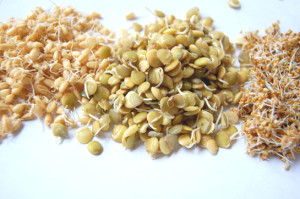 Now there’s a terrific way to maximize the nutritional prowess of seed plants like any nut, seed, and even grains and legumes. That’s by germination and continuing to full sprouting where possible. “Seeds” means any nut , seed, dried bean and even intact grain seed. Many biochemical found in plants aren’t found in the unsprouted seed. They simply are not needed until plant germinates and grows. Germination unleashes their entire innate nutritional capacity to create another living organism. Call it a “treasure chest” of “magically” released nutrients. Sprouting is the best way to maximize mineral and vitamins in these foods. For example, whole grains and legumes by themselves have no vitamin C. But when sprouted, the plant must begin to make it for its new life. For example, dry pinto beans have no vitamin C to speak of. But the amount of dry pinto beans (12 grams) that will make 100 grams of pinto beans sprouts will generate 21.7 or about 1/3 of the RDA for Vitamin C.
Now there’s a terrific way to maximize the nutritional prowess of seed plants like any nut, seed, and even grains and legumes. That’s by germination and continuing to full sprouting where possible. “Seeds” means any nut , seed, dried bean and even intact grain seed. Many biochemical found in plants aren’t found in the unsprouted seed. They simply are not needed until plant germinates and grows. Germination unleashes their entire innate nutritional capacity to create another living organism. Call it a “treasure chest” of “magically” released nutrients. Sprouting is the best way to maximize mineral and vitamins in these foods. For example, whole grains and legumes by themselves have no vitamin C. But when sprouted, the plant must begin to make it for its new life. For example, dry pinto beans have no vitamin C to speak of. But the amount of dry pinto beans (12 grams) that will make 100 grams of pinto beans sprouts will generate 21.7 or about 1/3 of the RDA for Vitamin C.
Broccoli sprouts have higher content of vitamin C than the C-rich, mature plant. They also have much higher amounts of cancer fighting phytochemicals than the mature plant (like sulforaphanes, the anti-cancer compound found in cruciferous vegetables). “Broccoli and penca kale sprouts may be especially important as source of vitamin C as they contain the highest amounts of this compound.” Sprouting removes phytic acid (and enzyme inhibitors) from beans, which could otherwise limit mineral absorption (or otherwise limit maximum digestion and absorption). Some of great sprouts that are great to eat raw and also contain nutrients like protein, Vitamin C and PEOs are alfalfa, almonds, broccoli, clover, pumpkin, radish and sunflower.
Mike Maunu – Founder
Oxygen4Life.com
